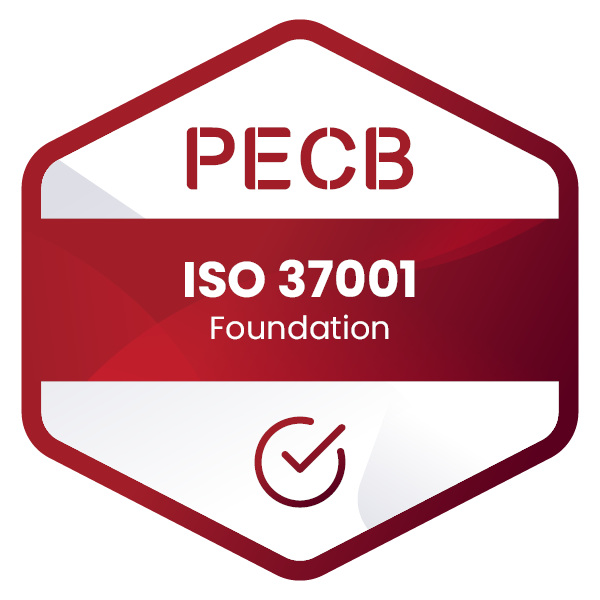Course Overview
The ISO 31000 Foundation training course presents the basic principles and approaches of managing risks and opportunities based on the guidelines of ISO 31000. This training course focuses on the main components of ISO 31000: basic terms and definitions, principles of risk management, risk management framework, and risk management process. In addition, each step of the risk management process is analyzed and elaborated individually.
Upon completion of the training course, you can sit for the exam and apply to obtain the “PECB Certificate Holder in ISO 31000 Foundation” designation. The certificate demonstrates that you understand the fundamental concepts of risk and methodologies for risk management based on the guidelines of ISO 31000.
Key Features Of ISO 37001 Foundation Certification
- Understanding of anti-bribery management principles
- Knowledge of ISO 37001 standards and requirements
- Skills in implementing anti-corruption policies and procedures
- Ability to conduct anti-bribery risk assessments
- Knowledge of legal and regulatory compliance related to bribery and corruption.
Why Choose CounselTrain for ISO 37001 Foundation Training in UAE?
Choosing CounselTrain for ISO 37001 Foundation Training in the UAE offers several advantages. CounselTrain provides expert-led training programs that cover all aspects of anti-bribery management based on ISO 37001 standards. Participants benefit from a comprehensive curriculum, practical insights, and hands-on experience in implementing anti-corruption policies and procedures. CounselTrain’s trainers are experienced professionals in anti-bribery management, ensuring a high-quality learning experience. The supportive learning environment, access to resources, and post-training support further enhance the value of choosing CounselTrain for ISO 37001 Foundation Training in the UAE.
Target Audiance
- Risk management professionals
- Individuals seeking to gain knowledge about the ISO 31000 guidelines for risk management principles, framework, and process
- Individuals responsible for the creation and protection of value in an organization
- Personnel tasked with managing the risks and opportunities in their area of responsibility
- Individuals interested to pursue a career as a risk manager
Schedule Dates
ISO 31000 Foundation
ISO 31000 Foundation
ISO 31000 Foundation
ISO 31000 Foundation
Course Content
- Introduction to risk management, ISO 31000 components, and initiation of the risk management process
- Risk assessment, risk treatment, recording and reporting, monitoring and review, and communication and consultation according to ISO 31000
ISO 37001 Foundation in United Arab Emirates
The ISO 37001 Foundation course in the United Arab Emirates (UAE) is essential for individuals and organizations looking to strengthen their anti-bribery management systems. This course covers fundamental principles of anti-corruption, compliance requirements, risk assessment methodologies, and best practices according to ISO 37001 standards. Participants gain insights into detecting and preventing bribery, establishing effective controls, and ensuring legal and regulatory compliance. The ISO 37001 Foundation in the UAE equips participants with the knowledge and tools necessary to implement robust anti-bribery measures, mitigate risks, and uphold ethical standards in business operations.
FAQs
ISO 31000 Foundation is a certification program designed to provide a fundamental understanding of risk management principles based on the ISO 31000 standard. It covers key concepts, principles, and guidelines for effective risk management in various organizational contexts.
ISO 31000 Foundation certification is beneficial for individuals involved in risk management processes within organizations, including risk managers, executives, project managers, business continuity professionals, and compliance officers. It is also valuable for those seeking a comprehensive understanding of risk management principles irrespective of their specific roles.
The ISO 31000 Foundation certification course typically covers essential topics such as the principles and guidelines of risk management according to ISO 31000, the risk management framework, risk identification, risk analysis, risk evaluation, risk treatment, monitoring, and communication of risk. Participants also gain insights into integrating risk management into organizational processes and enhancing decision-making through effective risk management practices.
Preparation for the ISO 31000 Foundation certification exam usually involves studying the ISO 31000 standard and related materials provided by accredited training providers. It’s recommended to attend training sessions conducted by experienced professionals, review study guides, and practice with sample exam questions to familiarize oneself with the format and content of the exam. Additionally, candidates can benefit from self-study resources, online courses, and engaging in discussions with peers to deepen their understanding of risk management principles outlined in ISO 31000.

 4.8
4.8




